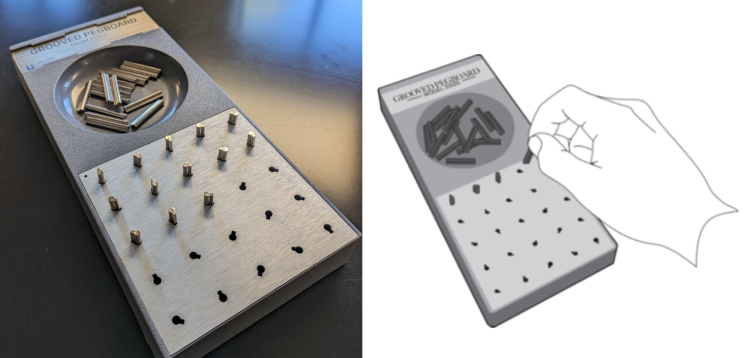Your brain remembers what your fingers used to do
New CU Boulder research demonstrates that, with practice, older adults can regain manual dexterity that may have seemed lost
Despite what ads for wrinkle cream would have us believe, there’s no magic reversal for aging. As the years pass, a certain amount of change is inevitable but not, it turns out, inexorable.
Fingers that feel less nimble in doing the normal tasks of life—buttoning a shirt, writing a list—are not doomed to stay that way, new research shows. It also demonstrates that, to some extent, age is just a number.
Researchers in the University of Colorado Boulder Department of Integrative Physiology—first author Sajjad Daneshgar and Taylor Tvrdy, both PhD students, and Professor Roger Enoka—worked with more than two dozen study participants ages 60 to 83 to understand whether manual dexterity can improve with time.

Sajjad Daneshgar, a PhD student in the CU Boulder Department of Integrative Physiology, conducted research that found manual dexterity can improve with practice in older age.
Over six sessions, participants completed a pegboard exercise multiple times, and after the sixth session, data showed that the average time it took to complete the pegboard had decreased for all participants.
“We saw that in older adults, training can improve hand function to a level it was at in middle age,” Daneshgar says. “In a way, practicing helped them go back a decade or two. Most people believe that aging has many negative challenges in terms of function in the hands, but this study shows that what you achieved in the past can really help you as you get older.”
Simple puzzle, complex process
For the study, Daneshgar and his research colleagues recruited right-handed older adults with no history of neurological disease. After an initial familiarization session and evaluation session, participants completed a grooved pegboard test 25 times in each of six sessions.
The test required participants to fit small, keyhole-shaped metal pegs into 25 holes on a board as quickly as possible. The keyholes had different orientations on the board, so participants not only had to manipulate the pegs with their fingers to get them situated correctly, but then fit them correctly.
“At first glance, this looks like a simple puzzle or game, but it’s actually a very complex process,” Daneshgar says. “Your mind is controlling your physical function—and we’re doing a lot more studies on this physical function and what’s going on in the muscles, in the nervous system—and we’re seeing that cognition of the mind, how you learn things, is connected to the muscles and how dexterous you are.”
For example, one of the study participants was a 67-year-old woman who played the piano in her youth. While the average time to complete the pegboard was between 40 and 50 seconds, she could do it in 36—a time faster than some of the researchers could achieve.
“Even though she wasn’t regularly playing the piano during the study, that tells us that perhaps the memory your brain has of controlling those muscles still exists,” Daneshgar says. “Some activities that people do—playing a musical instrument, rock climbing—can be very beneficial for manual dexterity, and even if they’re done earlier in life, the brain may remember controlling those muscles.”

During the research, study participants fit small, keyhole-shaped metal pegs into 25 holes on a board as quickly as possible.
Practice leads to improvement
However, those who reach their later years without a longtime history of guitar-playing or bouldering shouldn’t despair. Wherever study participants started at baseline—even if their initial times for completing the pegboard were comparatively slow—each saw improvement in their times by the sixth session.
“Manual dexterity can be improved by the brain,” Daneshgar says. “It’s not just at the level of the fingers. Signals from the brain are controlling function and practicing aids learning. This study shows that, as far as function in the limbs and hands, learning in terms of muscle training never ends. Whatever level you’re at, you can go back to this training and practicing to see improvement in function.”
Another important outcome from the research is demonstrating that categorizing people’s performance based on chronological age during their later years may not be the best way to understand manual dexterity.
“Whatever you learned in the past is going to be a main player in performance in older age,” Daneshgar says. “Of course, not all people in older age are going to have the same performance, but people who had better practice in the past can, in older age, practice and get to a place where they perform better than middle-age adults.
“But we also showed that practice helps everybody. It doesn’t matter if you have particular experience earlier in life, practice helps all people to do better with no exception.”
Manual dexterity is one of the National Institutes of Health Toolbox biomarkers of neurological health and motor function across the span of life. Daneshgar notes that the research demonstrates manual dexterity is not something that must inevitably worsen over time. With practice, the brain can remember what the fingers once did.
“Manual dexterity relates to our ability to button a shirt or hold a pen,” Daneshgar says. “These are the activities of daily life that we want to be able to do throughout our lives, and they’re abilities that we don’t need to lose.”
Did you enjoy this article? Subscribe to our newsletter. Passionate about integrative physiology? Show your support.

